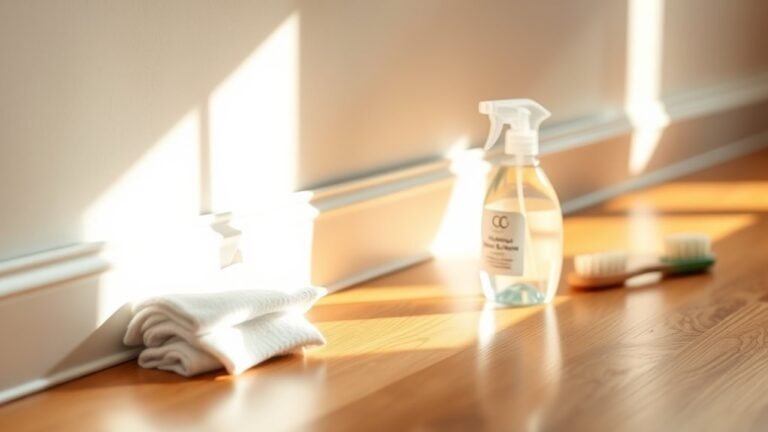How to Make Homemade Windowsills Cleaner
You can make a homemade windowsills cleaner by mixing equal parts white vinegar and water in a spray bottle for everyday cleaning. For stubborn stains, sprinkle baking soda on the area, dampen it to form a paste, and gently scrub. To polish wooden sills, combine lemon juice and olive oil, then apply with a soft cloth. Avoid harsh chemicals and use mild dish soap if needed. Keep your sills fresh and protected—more tips are ahead to help you maintain them easily.
Gather Your Cleaning Supplies

To get started, you’ll need a few basic cleaning supplies. Freedom means handling your space on your terms, so gather essential supplies that empower you to clean efficiently. Grab a soft cloth or microfiber towel to avoid scratches, a small brush for corners, and a spray bottle for homemade solutions later. Don’t forget gloves to protect your hands and a sturdy sponge for tougher spots. These cleaning tools are simple yet effective, giving you control without relying on harsh chemicals. Having these essentials ready lets you tackle windowsills with confidence, making the process quick and satisfying. By preparing your cleaning tools upfront, you set yourself free from frustration and guarantee your homemade cleaner works smoothly.
Prepare a Vinegar and Water Solution
Once you’ve gathered your supplies, mixing your cleaning solution is the next step. To harness the vinegar benefits, combine white vinegar and water using the right water ratios—typically, a 1:1 mix works well for everyday cleaning. This balance guarantees your solution is strong enough to cut through dirt and grime while remaining safe for most windowsill surfaces. If you want a gentler approach, try a 1 part vinegar to 2 parts water ratio. Vinegar naturally breaks down buildup without harsh chemicals, giving you a fresh, streak-free finish. Pour your solution into a spray bottle for easy application, and you’re set to clean freely and effectively. This simple mix respects your space and your desire for a natural, effective cleaner.
Use Baking Soda for Stubborn Stains

Three common household ingredients, including baking soda, can tackle even the toughest windowsill stains. When you’re dealing with stubborn grime, baking soda effectiveness truly shines. Simply sprinkle baking soda directly onto the stained area, then dampen it with a little water to form a paste. Let it sit for about 10 minutes to break down the dirt. Afterward, gently scrub the windowsill with a soft brush or cloth. Baking soda’s mild abrasiveness helps lift stains without damaging surfaces, making stain removal easier and safer. Rinse thoroughly with water and dry with a clean cloth. This method gives you the freedom to clean effectively using what’s already in your kitchen, avoiding harsh chemicals and keeping your space fresh and spotless.
Make a Lemon and Olive Oil Polish
You’ll need just two simple ingredients: lemon juice and olive oil. Mixing them creates a natural polish that brightens and protects your windowsills. Let me show you how to apply it for the best results.
Ingredients Needed
Creating a lemon and olive oil polish for your windowsills requires just a few simple ingredients you probably already have at home. You’ll need fresh lemon juice, which acts as a natural ingredient to break down grime and leave a fresh scent. Next, grab some extra virgin olive oil—an eco friendly option that nourishes wood and adds a soft shine without harsh chemicals. That’s it! These two ingredients combine to create an effective, non-toxic polish that respects both your health and the environment. If you want, you can also add a few drops of essential oil for extra fragrance, but it’s completely optional. By using such natural ingredients, you’re choosing freedom from synthetic cleaners and embracing simple, sustainable care for your windowsills.
Application Steps
To start, mix two tablespoons of fresh lemon juice with four tablespoons of extra virgin olive oil in a small bowl. This blend creates a natural polish that not only cleans but nourishes your windowsills. Using a soft cloth, apply the mixture evenly, following smooth, circular application techniques to guarantee every inch is covered. Let it sit for a few minutes to break down dirt and grime. Then, wipe away any excess with a clean, dry cloth to reveal a fresh, vibrant surface. For lasting results, maintain a regular cleaning frequency—once every two weeks keeps your windowsills looking their best without extra effort. This method empowers you to take control of your space, using simple, natural ingredients for a cleaner home.
Apply a Mild Dish Soap Mixture

One simple way to tackle grime on your windowsills is by using a mild dish soap mixture. Dish soap benefits include breaking down dirt without harsh chemicals, making it a perfect choice for everyday cleaning. To get started, mix a few drops of dish soap with warm water. Then, use these cleaning techniques to refresh your windowsills:
- Dip a soft cloth or sponge into the mixture
- Gently scrub the windowsills to lift dirt and dust
- Rinse the cloth and wipe away soap residue
- Dry with a clean towel to prevent streaks
This method gives you control over what touches your home, keeping your space fresh without the fuss. Freedom in cleaning means using simple, effective solutions you trust.
Cleaning Wooden Windowsills Safely
When cleaning wooden windowsills, you’ll want to use gentle solutions that won’t harm the wood’s finish. Avoid harsh chemicals or excessive water that can cause damage over time. By choosing the right methods, you can keep your windowsills clean and well-preserved.
Gentle Cleaning Solutions
Although wooden windowsills can add charm to your home, they require gentle care to avoid damage. You’ll want to use cleaning solutions that respect the wood’s natural beauty while keeping your space eco friendly. Opt for natural ingredients that won’t strip or harm the surface. Here are some gentle cleaning solutions you can try:
- Mix mild dish soap with warm water for a simple, effective cleaner
- Use white vinegar diluted in water to tackle grime without harsh chemicals
- Combine baking soda and water into a paste for stubborn spots
- Apply a few drops of olive oil to polish and protect the wood
These options let you clean freely, without worrying about harsh toxins or damage, keeping your wooden windowsills fresh and vibrant.
Preventing Wood Damage
To keep your wooden windowsills looking their best, you’ll need to clean them carefully to prevent damage. Start by using gentle, homemade cleaners that won’t strip away the wood’s natural oils or finish. Avoid soaking the wood; instead, use a damp cloth to minimize moisture exposure. Moisture prevention is key since water can seep into the grain, causing warping or rot. After cleaning, dry the surface thoroughly. Applying a protective finish or wood protection oil regularly helps seal the wood, guarding it against humidity and dirt. This simple routine keeps your windowsills strong and beautiful, giving you the freedom to enjoy fresh air without worrying about costly repairs. Taking these steps guarantees your wooden windowsills stay durable and damage-free for years to come.
Tips for Maintaining Clean Windowsills Regularly
Keeping your windowsills clean doesn’t have to be a chore if you develop a simple routine. With consistent windowsill upkeep, you’ll enjoy a fresher, brighter space without feeling trapped by endless cleaning. Here are some tips to keep your cleaning routine easy and effective:
- Wipe down windowsills weekly with a damp cloth to prevent dust buildup.
- Use a mild homemade cleaner to tackle stubborn dirt without harsh chemicals.
- Dry windowsills thoroughly to avoid moisture damage and mold growth.
- Declutter the area regularly to stop dirt from accumulating unnoticed.
Frequently Asked Questions
Can I Use Commercial Cleaners Instead of Homemade Solutions?
You absolutely can use commercial cleaners instead of homemade solutions if you want. Using commercial products often offers strong cleaning effectiveness and can save you time. However, they might contain harsher chemicals, so if you prefer a more natural approach or have sensitivities, homemade options give you more freedom to control ingredients. Ultimately, the choice depends on your priorities—whether you value convenience, power, or a gentler, customizable clean.
How Often Should I Deep Clean My Windowsills?
You should set a deep cleaning frequency for your windowsills about every three to six months, depending on how much dust and dirt gather. Regular windowsill maintenance, like quick wipe-downs weekly, keeps things easy and lets you enjoy a fresh space without feeling chained to chores. By staying consistent, you free yourself from buildup and keep your home feeling open and inviting, without the stress of last-minute scrubbing marathons.
Are These Cleaning Methods Safe for Painted Windowsills?
You’ll want to be careful with your cleaning techniques to protect paint durability on your windowsills. Gentle, homemade solutions like mild soap and water usually won’t damage the paint if you avoid harsh scrubbing. Steer clear of abrasive cleaners or strong chemicals, which can wear down the paint over time. By choosing safe methods, you maintain both the look and freedom to clean without worrying about ruining your painted surfaces.
Can I Use Essential Oils in the Cleaning Solution?
You might worry essential oils could damage painted surfaces, but they’re generally safe when diluted properly. Using essential oils in your cleaning solution recipes not only adds a fresh scent but also brings natural antibacterial and antifungal benefits. Just mix a few drops with water and mild soap for an effective, eco-friendly cleaner. This way, you keep your windowsills spotless without harsh chemicals, letting you enjoy a fresher, freer home environment.
What Should I Do if Mold Appears on My Windowsills?
If mold appears on your windowsills, you’ll want to clean it promptly using a mixture of vinegar and water or a mold-specific cleaner. Afterward, focus on mold prevention by improving ventilation and reducing moisture. Increasing your cleaning frequency helps too—wiping down windowsills weekly can keep mold at bay. Staying consistent gives you the freedom to enjoy a fresh, mold-free space without hassle, letting you breathe easy and live freely.






